Event Triggers
ActiveBatch supports a wide variety of event triggers. An event trigger is different from a date/time trigger because ActiveBatch is monitoring for an external event to occur, and when it does, a trigger occurs. An external event is not controlled by ActiveBatch, the way date and time triggers are. Event triggers may occur in a predictable manner - or be completely random.
A File Trigger is one example of an event trigger. When this trigger is configured on a Job, ActiveBatch monitors a specified directory for changes (e.g. a new file has been added, modified or deleted), and when that happens, the Job triggers. Event triggers are useful because the event is typically an indicator that the Job is ready to run. Using the File Trigger example, the file that has been added to a monitored directory may be the file that the Job must process (the payload of the Job uses the file). Rather than scheduling a Job at a time you think the file may arrive, then use a file constraint to periodically check for the file arrival - you can use the arrival of the file as the trigger mechanism. This takes the guesswork out of setting up a schedule and configuring file constraints. You know the file is available because the File Event detected its arrival. The Job can be dispatched immediately upon the arrival of the file. No schedules or constraints are required.
Event triggers can be added to all triggerable objects (Jobs/Plans/references). They are configured on the Triggers property sheet, as depicted in the image below. This image was taken from a Job property sheet, but it is the same for plans and references.
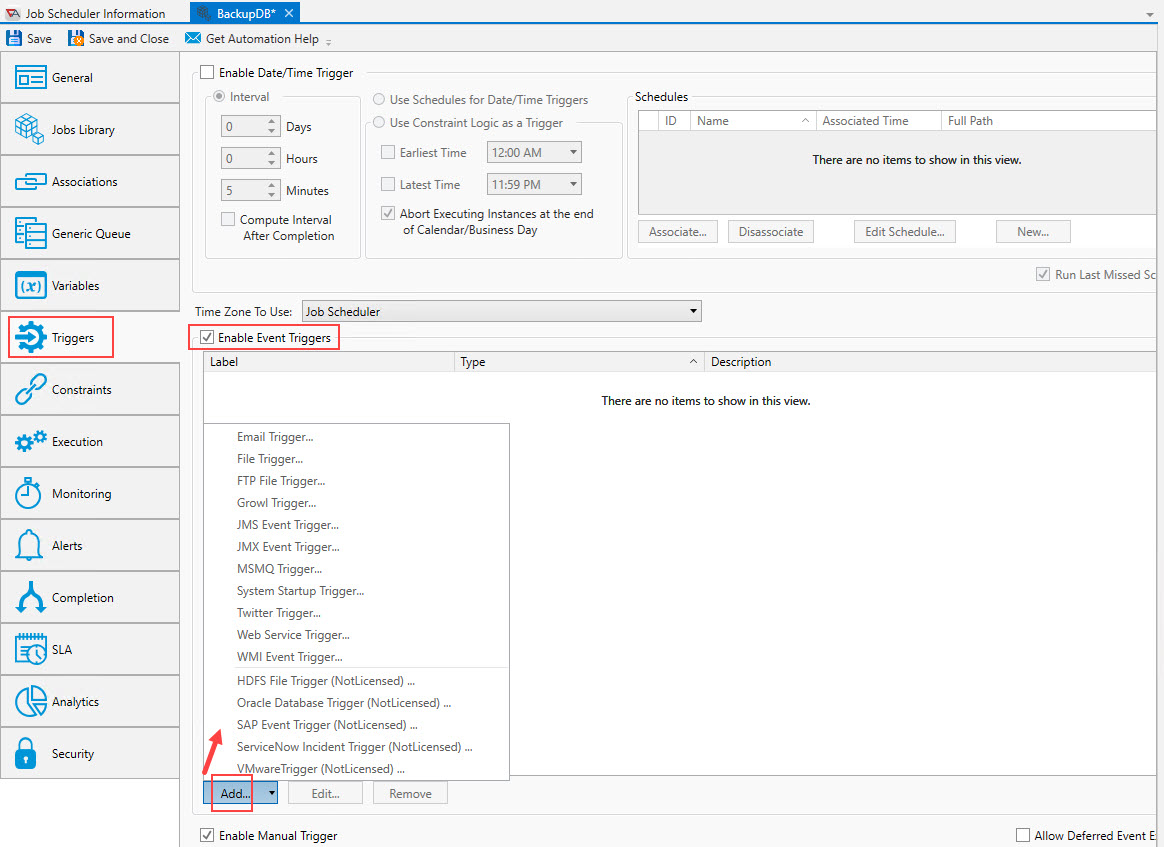
To configure any event type trigger, check the Enable Event Triggers checkbox. Next, there are two other checkboxes on the Trigger property sheet which are:
Enable Manual Trigger - By default, this checkbox is enabled. When checked, it means the object can be triggered manually using various methods that access the "Trigger" command, where the most common is using AbatConsole or WebConsole (e.g. a right-click > Trigger or Trigger > (Advanced) menu option). This property, despite where it is located, it is not related to Event triggers in any way.
Allow Deferred Event Execution - By default, when an event occurs during an “excluded” period (i.e. a period the object is not to execute) the triggering event is ignored. If the Allow Deferred property is checked, then the triggered instance will be dispatched as soon as the exclusionary period is over. Exclusionary periods are configured on the Constraints property sheet. See Date/Time Constraints This includes any exclusions specified in the Date/Time list, and exclusions specified using one or more associated Calendar objects. If an event trigger occurs during an exclusionary period when the Allow Deferred checkbox is enabled, an instance will be created, but it will go into a "Waiting Date/Time" state. The waiting instance's Execution Time will specify the time the instance will move into an executing state (again, after the exclusionary period is over). As an example, if the event trigger occurred during a Calendar holiday, then the Execution Time would be the start of the next business day.
If you anticipate multiple events occurring during an exclusionary period, and you would like all events to create a waiting instance, be sure to configure the triggerable objects Execution > If Active properties to allow the creation of multiple instances. If the default value of "Skip" is set, only one instance can be active at a time. Any instance that is not complete (success, failure or aborted) is considered active. As an example, if 10 file trigger events occur during an exclusionary period, and If Active is set to "Skip", only one instance for one file trigger will be created. The rest of the events would be ignored.
Note: The Allow Deferred property is not applicable to a manual Trigger operation.
To add a new event trigger, Click the Add button as depicted in the image above. Currently, sixteen (16) event trigger operations are supported. Five (5) additional event trigger operations are available via separate licensing and purchase: HDFS File Trigger, Oracle Database Trigger, SAP Event, ServiceNow and VMwareTrigger.
Common Event Trigger Properties
There are two properties that appear on almost all ActiveBatch Event Triggers (except WMI and System Startup events): Queue and User, as depicted in the image below (see the bottom 2 properties).
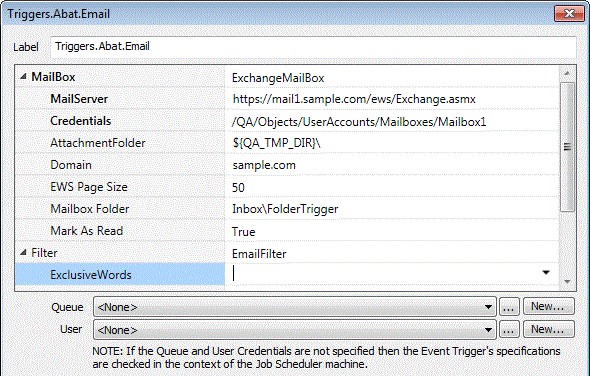
The Queue property represents an (and therefore the Execution Machine) that the Event Trigger will be initiated from. By default, if the Queue is omitted, the Event is initiated from the Job Scheduler’s machine. With the exception of the File Trigger event, the Execution Queue specified must represent a Windows machine platform with the appropriate software installed as it relates to the event type selected (i.e. JMS, Growl, etc).
The User property represents a User Account object whose security credentials will be used to initiate the ActiveBatch Event framework (other than the File Trigger event in which case the security credentials are used when performing the File Trigger event itself). The ActiveBatch Event Framework is a process that then initiates the various supported events. With the exception of File Trigger, all the other events use this two-stage process. By default, when the User Account is omitted, the ActiveBatch service account is used to initiate the ActiveBatch Event framework. With the exception as noted above, that’s fine because the actual event itself will still require security credentials to perfect the event trigger you want to enable. For File Trigger events, we recommend that you do specify a User Account object since those events, in particular, assume a “default” security context (in other words, they use the credentials of whatever initiated the Framework).
Next, there are a couple of other properties you can configure for each event you create.
Trigger Once Only: If enabled, this event is triggered once (when the event occurs) and then is disabled for the life of the object.
Expected Date Times: This facility, when enabled, allows you to associate a date and time with an expected event, which is useful when the event occurrence is predictable.
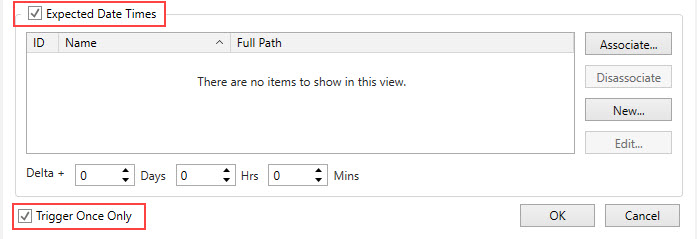
In many cases, events are not predictable. This means views such as the Daily Activity view, the Runbook or Operations views - do not depict expected future runs since no date or time expectations are configured. It is very possible that the event trigger will occur randomly, on random dates and/or at random times. In that case, this Expected Date Time feature would not be useful.
Alternatively, if there are scenarios in which you can predict when an event will occur, you may find this feature useful. It allows you to associate one or more Schedule Objects that are configured with the dates and times you expect the event to occur. The triggerable objects may not run at exactly that time, therefore you are using this feature to set general expectations, which is especially helpful when:
-
Displaying various instances views that depict future runs (it provides a more accurate picture as to what is coming).
-
You would like to alert users if the event does not occur. The alert type is named: Job/Plan missed expected trigger. You must configure this alert if you would like to use it.
Note: When Schedule(s) are associated this way - on the Event property sheet, the Schedule object will not produce date and time triggers but rather, date and time expectations are set.
When looking at future runs for objects configured using Expected Date Time, you will see a state of "Not Run (E)", where the E stands for Expected trigger. The Execution Time field for the future run will be the expected trigger time, based on what was set in the Schedule object.
The Delta field allows further flexibility when setting up an expected time frame for your triggerable object. It expands the expected trigger time window, beyond the set time taken from the Schedule object. It also represents the amount of time that can go by before missed expected trigger alert (described above) goes out - if the expected event does not occur by the Scheduled time plus the Delta time. The alert is useful when a predictable event does not occur because there could be an underlying issue that needs to be investigated.
To use the facility, enable the Expected Date Times checkbox, as depicted in the image below. You can add one or more Schedule objects that include the date(s) and time(s) the event is expected to occur. Click the Associate button if you have an existing Schedule object to add. To disassociate a schedule, select the schedule in the list, then click the Disassociate button. To edit a schedule, select the schedule in the list, then click the Edit button. To add a new schedule, click the New button and configure the new schedule object accordingly.

The settings above depict a Schedule object named M-F_2_10PM which produces a weekday time expectation of 2:10pm. Combined with the Delta property of (30) minutes, this effectively produces an expectation that this Plan or Job is expected to run each day between the hours of 2:10pm and 2:40pm (not including the duration of the Plan/Job itself). If the event does not occur by 2:40pm and the missed expected alert is configured, the alert will go out at that time.

The example above, using the Daily Activity view, depicts the same Job with an “expected” (E) future run-time of 2:10pm.
Now that the common Event trigger properties have been described, this topic will now describe each event trigger in detail. Expand the desired event trigger to learn more about it.
The E-Mail Trigger allows you to trigger a Plan or Job based on various criteria within a received E-Mail message.

Mailbox: ActiveBatch currently supports two (2) mailboxes for accessing e-mail as an event trigger: Microsoft Exchange (and Hosted Exchange) and POP3. Clicking on the dropdown shows the two possible choices. When selected the input parameters for your selection are displayed.
This section describes the properties needed for accessing the selected user’s mailbox using Microsoft Exchange.
-
MailServer: This property is the host name or FQDN of your Microsoft Exchange mail server OR the URL endpoint of your EWS server (for example, https://mymail.company.com/EWS/Exchange.asmx).
-
Credentials: This property is used to specify the actual user’s mailbox. Please select a User Account object representing the proper credentials by clicking on the dropdown.
Note: The User Account “username” property must employ UPN (User Principal Name) syntax (i.e. user@company.com) as this will be used to denote the target mailbox.
-
AttachmentFolder: This property is used to indicate that, if the received e-mail contains attachments, you would like the attachments created in the folder specified. If the e-mail does not have attachments nothing will be created. The filenames of the attachments are taken from the e-mail itself. If this property is omitted, then attachments are not externally saved.
-
Domain: This property is used when accessing a hosted Exchange server in which the domain needs to be specified along with the Username and Password credentials. If omitted, only the security credentials as specified in the User Account object will be used.
-
EWS Page Size: This optional property indicates the number of mailbox messages that will be processed at any one time. By default, that value is 50. Specify a higher value if the mailbox will be receiving more than that value at any one time.
-
Mailbox Folder: This optional property allows you to specify a mailbox folder or sub-folder. By default, the folder “InBox” is used. If specified the syntax is “ParentFolder\sub-folder” where “ParentFolder” is a Microsoft Well-Known folder name. (EWS Only).
-
Mark As Read: This optional Boolean property indicates whether you want the messages in the mailbox to be considered to have been read when the trigger is processed. This is very useful when the mailbox is only used for automated processing. By default, mailbox messages are not considered to have been read.
This section describes the properties that may be optionally specified if you need to filter for specific criteria that the mail message is to have for the trigger to be performed.
-
ExclusiveWords: If specified, one or more words (or phrases), separated by a comma, whose absence in the incoming E-Mail message body is necessary in order to act as a trigger.
-
From: If specified, indicates the “From” field that must match the incoming E-Mail (multiple addresses can be specified separated by a comma).
-
HasAttachment: If specified this optional Boolean parameter, allows you to ignore whether an e-mail has an attachment or not. If True is specified, the E-Mail must contain an attachment to be considered. If False the email must not contain an attachment. If omitted, no attachment requirement is imposed.
-
InclusiveWords: If specified, one or more words (or phrases), separated by a comma, whose presence must be contained in the incoming E-Mail message body in order to act as a trigger.
-
Subject: If specified, one or more words (or phrases), separated by a comma, whose presence must be contained in the “Subject” field in order to act as a trigger.
-
To: If specified, indicates the “To” field that must match the incoming E-Mail (multiple addresses can be specified separated by a comma).
This section describes the properties needed for accessing the selected user’s mailbox using POP3.
-
MailServer: This property indicates the machine name for your POP3 Mail server. Typically this would be a fully qualified domain name.
-
Credentials: This property is used to specify the Windows credentials to be used when accessing the mailbox. Please select a User Account object representing the proper credentials by clicking on the dropdown.
-
Port: This property contains the POP3 port number. By default, 110 is used.
-
UseSSL: This Boolean property indicates whether SSL (Secure) POP3 should be used. The default is False. Please note that if you set this property to true you will probably also need to change the port number.
ExclusiveWords, InclusiveWords and Subject also support wildcards (asterisk for multi-character wildcard and question mark for single character wildcard). As multiple entries are comma separated, a phrase containing an embedded space is valid and does not require a quoted string. All matches are performed in a case-less manner.
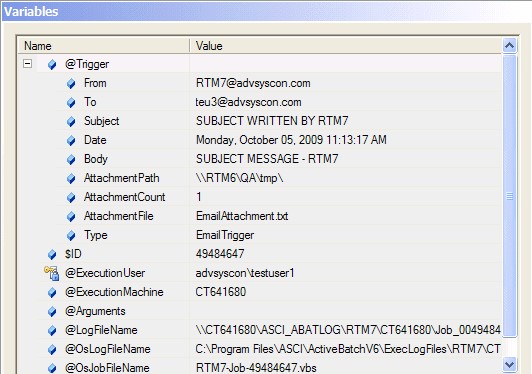
The above figure displays the @Trigger structure variables that are passed back from a successful e-mail event. When multiple files are attached, the “AttachmentFile” variable is a comma separated list of files stored within “AttachmentPath”. In a later release of ActiveBatch, an additional variable was been added to the above structure named .RawBody. Where “.Body removes all HTML and formatting characters (i.e. newlines), .RawBody does not. All HTML and/or formatting characters are left intact.
The System Startup event will trigger a Job/Plan when the Job Scheduler service is started or restarted. When you select this event, the onStartup value will be set to True. Keep this value, then click OK to save. This is all you need to do when using this event trigger.

The File Trigger event provides you with the ability to specify a folder, recursive set of folders and/or specific file(s) (using wildcards) in which one or more files are subject to a file operation occurring. When that operation occurs, the event is produced and the Job/Plan is triggered for execution.
Supported file operations through the Filter are: Created, Changed, Deleted and Appeared (renamed). By default, the creation operation is enabled. File Event is therefore especially helpful when you want to trigger a Job/Plan based on the creation of a file. Appeared is useful when a new file may be created in another directory and then later moved to the target directory. Windows IIS server uses this technique when downloading a file.
Note: If using the Delete file operation, please note that some Windows facilities (i.e. DOS/CMD) use the short-form filename for these operations. This means you must also use the short form name for the proper pattern matching.
You can specify a specific file or a directory specification. For example, if you want to trigger a Job/Plan based upon the reception of a file through FTP, the trigger will occur only after FTP has populated the file (see note below).
Note: An Exclusive access check is implicitly performed on the target file(s) to determine if the file trigger event may be declared. If this check fails, ActiveBatch will poll the file(s) starting with a one (1) second delay and build to a sixty (60) second delay the longer it takes for the Exclusive access check to be successful.
The “changed” operation is subject to certain limitations imposed by Windows and other platforms. In particular file size and date processing may not be timely due to caching considerations (see note below)
Note: If using the “changed” filter, understand that multiple unintended trigger operations can occur (even with ActiveBatch attempting to suppress). In addition, each operating system handles caching of directories differently so updates may not be timely or even match with file changes you know are occurring. For this reason we caution your use of this filter as it can be problematic unless you’ve experimented with your actual intended use.
Recursive refers to whether the specified directory should also include any nested sub-directories. If enabled, sub-directories are included. When monitoring directories, please note that the ending backslash is required as in the above example. You can also use wildcards such as C:\test\*.*.
For monitoring files on non-Windows systems you must specify Queue and User properties. The Queue represents the machine in whose context the “File Trigger” specification will be interpreted (for example, C:\test\ would be a local C drive on that Execution Queue/machine). The User property indicates the security credentials that will be used for file monitoring.
For monitoring files on Windows system you may specify Queue and User properties. If you omit these properties the file monitoring will be performed on the Job Scheduler machine and use the Scheduler’s service credentials. If you specify the Queue property the file monitoring will be performed on that Execution Queue/machine. If you specify the User property the file monitoring will be performed using the specified security credentials.
Note: By default, all file specifications are evaluated from the Job Scheduler machine’s point-of-view. This is the case when the “Queue” property is left blank. If the Queue property is completed, the file specification will be evaluated from the target Execution machine’s point-of-view.
Note: You may use ActiveBatch variables for the “File Trigger” property, however, they are only evaluated once when the triggered is declared (typically on Job Scheduler startup).
Note: File Triggers performed on Windows use the Directory Change Notification (DCN) facility. This facility does have limitations in terms of the number of outstanding directories that may be watched as well as the number of outstanding file triggers at any one time that may be executed. For more information, please read the Knowledge Base articles “File Trigger Session Limitations” and “File Triggers and simultaneous events”. The “File Trigger Session Limitations” article in particular also references the Microsoft article that speaks to various quotas that may need to be increased. This is especially true if you intend to watch or access over 100 file trigger events. As of V8 a change has been made to improve reliability in the event of a DCN failure. In the event of a DCN failure (for example, a network share was specified and the host sharing that directory lost connection), on resumption of DCN, a check is made to determine “created/appeared” and “deleted” changes. Those file trigger events will then be initiated. Please note that if a file is created and deleted before the DCN can be resumed, ActiveBatch will not be aware of the directory changes. Users must ensure that directories to be watched do not contain thousands of files for optimum performance.
Note: File Triggers performed on a non-Windows system use a built-in polling mechanism to determine directory changes. By default the poll is thirty (30) seconds. Users must ensure that directories to be watched do not contain thousands of files for optimum performance.
Note: If you prefix a File Trigger specification with “poll:” (case-insensitive) that will cause Polling logic to be used instead of DCN on Windows systems. “poll:” has no effect on non-Windows systems since that is the only mechanism available.

In the above example, the @Trigger variable structure contains several useful variables to help identify the specific file that caused the event. Note that .FileName contains the complete file specification where .FileTitle contains just the filename and extension portion. This can be useful if you need to move the file to another location.
File Triggers also support the use of Regular Expressions in a manner similar to that of the Success Code Rule Search String. Prefixing a File Trigger specification with “regex:” will cause the File Trigger specification to be viewed in the context of a Regular expression. For example, regex:c:\test\regpoll[0-9].bat allows for any file containing regpoll0.bat through regpoll9.bat to be included. If you need to also include the poll: prefix, regexpoll: should be specified. File Trigger Regular Expression support is available for Microsoft Windows, UNIX systems and OpenVMS. Please note that some minor differences in the handling of Regular Expressions may be present between OSes due to differences in the underlying RegEx engines used.
FTP File Trigger events provides you with the ability to specify a folder, recursive set of folders and/or specific file(s) (using wildcards), on a specific FTP server, to determine when a file is subject to a file operation occurring. When that operation occurs, the event is produced. For example, if a file is created on an FTP server within \etc\test, an event is produced and the Plan or Job is triggered. File operations include Created, Deleted, and Modified.
By creating an FTP File Trigger event you can avoid the workload of polling an FTP server and instead create a workflow when a file(s) is created, modified or deleted on an FTP server.
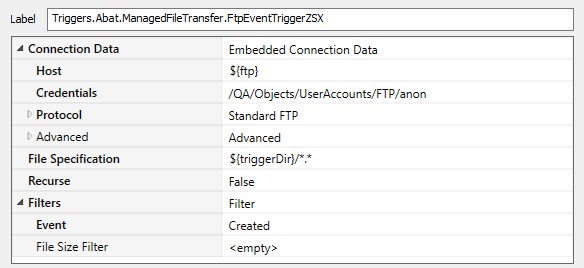
The FTP File Trigger event consists of three (3) sections. The first is the Connection Data. You can either specify the server and security credentials within the trigger (known as “embedded”) or by reference to a special User Account (known as “managed”). Part of the Connection Data is what type of FTP protocol you’ll be using: Standard FTP (which includes FTP as well as FTPS (SSL FTP) or Secure Shell FTP (SFTP). The second part is the File Specification and Recursion. This area indicates the type of file specification (folder or folder/file) and any wildcards used. Recursion indicates whether sub-directories are to be examined. The last part is the Filters specification. This include whether the event is to be generated when a file is created, modified or deleted. In addition, you can specify a size parameter as well as a comparison operator to be applied to the desired file size.
Note: This event does perform polling using a global value that is part of the event extension. The default is five (5) minutes but can be changed by the ActiveBatch Administrator.
The JMS Event Trigger allows you to trigger a Plan or Job based on receiving a JMS message from a selected Queue. The message (both body and properties) can be subject to additional filter criteria that must be met before the trigger action can be performed. JRE V1.8 or later is required to be installed on the Job Scheduler machine for this event to be operational.

JMS Provider Info: This collection of properties represents the JMS server and software you are attempting to connect to. The dropdown lists of the JMS servers that has been tested. A custom setting is available for you to add a new JMS configuration.

-
JMS Provider Name: This is the name of the JMS server software.
-
InitialContextFactoryName: This is the name of the Initial Context Factory class for the JMS server’s JNDI implementation.
-
Protocol: This is the protocol that will be used to connect to the JMS server.
-
Machine Name: This is the machine where the JMS server software resides. For TIBCO only, failover is supported by specifying a comma separated list of machine names where a machine name is a legal hostname and optional colon port-number (i.e. server1:3717).
-
Port Number: This is the TCP/IP port number that will be used for communication.
-
Jar Location(s): This the location of the required Jar files necessary to communicate with the JMS server.
JNDI Connection Factory Name: This property represents the JNDI name of a Connection Factory object. A ConnectionFactory object encapsulates a set of connection configuration parameters that has been defined by an administrator.
JNDI Destination Queue Name: This property represents concerns the destination queue name for the possible JMS message to be received. This destination object can be a queue or a topic.
Credentials: This property, if specified, provides authentication for the JMS receive. The property represents a User Account object with a username and password that is appropriate for JMS authentication with your JMS provider.
Topic Durable Subscription Name: This property, if specified, indicates the durable subscription name for this topic.
Message Header Filter: This property indicates filter criteria for the message properties that must match for the message to be considered event-able.
Message Content Filter: This property indicates filter criteria for the message content that must match for the message to be considered event-able.
The JMX Event Trigger allows you to trigger a Plan or Job based on the specification of a JMX attribute. You can further indicate the value of the attribute that must be met before the trigger action can be performed. JRE V1.8 or later is required to be installed on the Job Scheduler machine for this event to be operational.
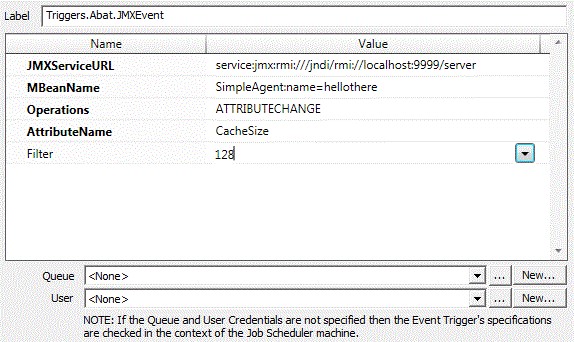
JMXServiceURL: This property contains the URL of your JMX server. The format is similar to:
“service:jmxrmi:///jndi/rmi://server-name:port-number/page where “server-name” is the host name of the JMX server, port-number is the port number being used by that JMX server and page is the directory being used for JMX connections.
MBeanName: This dropdown lists the mbean names that are housed on the JMX server.
Operations: This selection sheet helper allows you to select those operations you’re interested in monitoring. Currently only Attribute Change is supported.
AttributeName: This dropdown lists the attribute names for the mbean you’ve selected.
Filter: This property, if specified, indicates the value the attribute must be to allow the event to occur.
The MSMQ Trigger allows you to trigger a Plan or Job based on the reception of a message to a selected MSMQ queue.
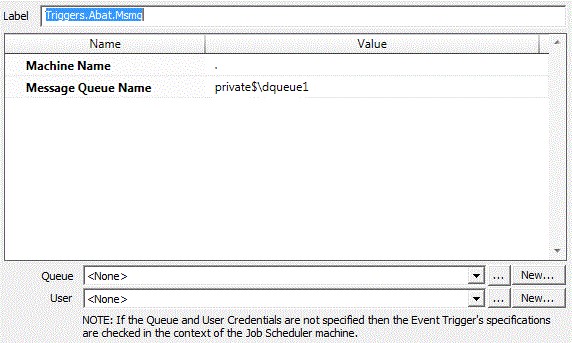
MachineName: This property indicates the name of the machine that is hosting the MSMQ system.
MessageQueueName: This property indicates the name of the Queue that you want ActiveBatch to use for triggering operations.
The Twitter Trigger allows you to trigger a Plan or Job based on a message received by a specified Twitter account using Twitter Authentication. You can further indicate filter criteria for the message itself and whether a trigger action should take place.
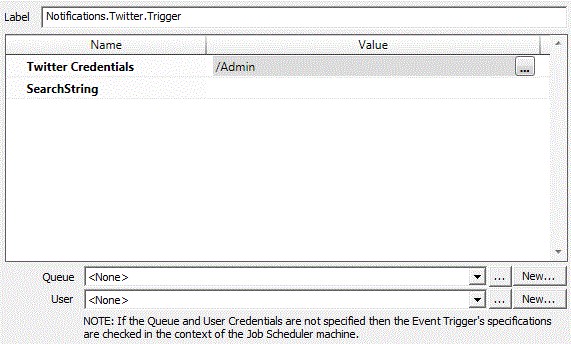
Twitter Credentials: This property is a User Account object with Twitter Authentication enabled. The object must allow proper access to Twitter through a security token.
SearchString: This optional property represents search criteria for the event. When a tweet is received, the search string is compared to determine if the message meets the eligibility criteria. If so, the event triggers the objects. If omitted, any received message will satisfy the event requirements.
The Web Service Trigger allows you to trigger a Plan or Job based on an event generated by a Web Service. Since a Web Service needs an “endpoint” or destination to send its web service message to, this facility creates those endpoints for you. The basic dialog deals with naming the endpoint (and making sure it’s unique), setting its security requirements and specifying an optional filter. Every web service endpoint also provides a Trigger method to allow an ActiveBatch aware web service the ability to trigger objects.
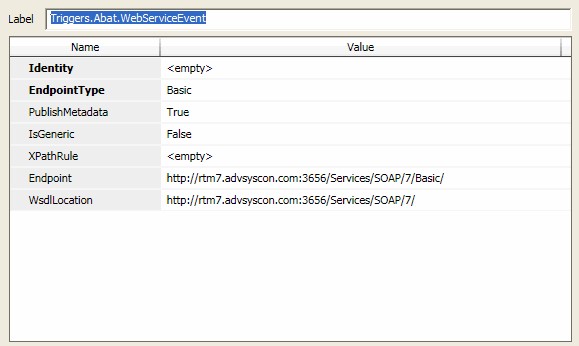
Identity: This property is used to create a unique endpoint. The created endpoint must be unique Job Scheduler wide (since the Job Scheduler is the publisher of all endpoints system wide). Please note that once you create a reference to the endpoint you should never change this value. Doing so, would cause you to also have to change all references to both the Endpoint and WsdlLocation.
EndpointType: This property is used to denote the type of endpoint that will be used. Four (4) options are supported: Basic, Secure, SecureCertificate and SecureUsername. Basic refers to a completely clear text, no security authentication required endpoint (think http://). The other three “Secure” options all support https: level communications. Secure indicates that no authentication credentials are required, SecureCertificate indicates that a valid client certificate is required to communicate with this endpoint. SecureUserName indicates that a username and password are required to communicate with this endpoint.
PublishMetadata: This property indicates whether the Job Scheduler will publish the endpoint as a Hosted Web Services. You can check which web service endpoints are published by copying the “Endpoint” property to a web browser. You will then receive a list of all published web service endpoints. A “true” property indicates the endpoint should be published. “False” indicates it shouldn’t be published.
IsGeneric: This Boolean property indicates whether the incoming message must adhere to the message standards imposed by the Wsdl schema or whether the message can be free formatted. A value of “true” indicates that a free formatted message is allowed and a value of false indicates that adherence to the Wsdl is required. This property does affect the setting of the @Trigger variable. A value of “true” will cause the XML Body and Headers to be returned. A value of “false” will result in only the user-specified variables, if any, returned. Note: The sending web service will receive an error if this setting is not adhered to.
XPathRule: This optional property indicates that an XPathRule filter will be applied to the message. If the filter expression is true, the message will be allowed to trigger the object. If omitted, any valid message will trigger the object.
Endpoint: (Read Only) For convenience the actual endpoint URL is displayed. This URL can be copied into a browser to examine and test the endpoint.
WsdlLocation: (Read Only) For convenience the base Wsdl specification is displayed.
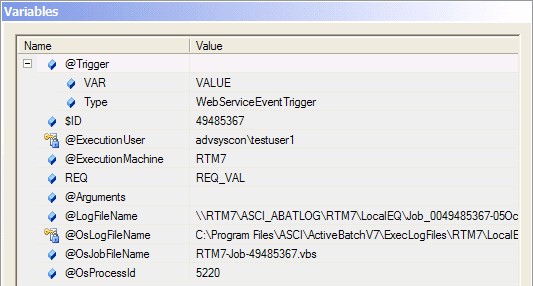
The above figure displays the @Trigger structure variables that are passed back from a successful Web Service event. The variable VAR value is set by the caller of the Web Service and available to the underlying triggered object.
ActiveBatch supports the integrated use of Microsoft Windows Management Instrumentation or WMI. WMI is Microsoft’s implementation of Web Based Enterprise Management (WBEM). ActiveBatch is both an Event Provider and Event Consumer. This means that ActiveBatch can register for any interested events and is notified by WMI when they occur. This section discusses the consumer aspects of ActiveBatch.

Note: WMI must be active on the Job Scheduler machine for you to issue WMI Event triggers.
ActiveBatch allows Job authors to indicate the events that a Job or Plan may be interested in and can trigger execution of the object when the event occurs. After completing the requested information, click OK to confirm and apply or click Cancel to cancel any addition or changes to the list of event(s).
The dialog box requests that a WMI query be entered. For maximum flexibility, ActiveBatch supports the use of WQL (WMI Query Language, similar in syntax to SQL).
WMI Event. Enter WQL string below: This mandatory field takes a valid WQL statement describing the event you’re interested in. All WQL statements begin with SELECT. You are not restricted in what you can enter however, you should not specify polling intervals that would adversely impact ActiveBatch and/or system performance. The example above shows a WQL query requesting an event be triggered if the “Telnet” service enters a “stopped” state.
Namespace: You must indicate the namespace to connect to. The Namespace specification is:
\\machine\namespace, for example, ROOT\CIMV2 is the namespace for the local machine. In the above example, ${VM} represents a machine. Note: This variable will be evaluated only once when the trigger is armed.
Privileges: This field allows you to add or remove any specific privilege that the selected WMI provider will use to execute your query. Clicking the Add button causes two (2) properties to be shown:
Privilege and Enabled. Privilege is a dropdown list of all the possible privileges and Enabled is a Boolean property that indicates whether the specified privilege should be enabled or not.
User Information: This section allows you to select a User Account to associate with this event. The drop down button allows you to select specifying either a User Account object or an embedded Username/Password. It is highly recommended using a User Account Object instead of embedding the Username/Password within the Job itself. For a local machine (Job Scheduler machine) the ActiveBatch Event Framework authentication credentials are used and WMI does not support the specification of different authentication credentials for a “local” machine. For non-Job Scheduler machines you must specify authentication credentials that will be used for WMI Event processing. As with other portions of ActiveBatch, you can indicate that the username and password are to be saved.
-
User Account: This property causes a dropdown list of all User Account objects that you can specify. You would select one.
-
Username/Password: This pair of properties represents the embedded username and password.
Authority: (Optional) Server Principal Name.
Authentication Level: (Optional) Authentication Level
Impersonation Level: (Optional) Impersonation Level
Run Job on Event Machine (Generic Queue Only): You can indicate to ActiveBatch that the Job Queue to select is the machine that actually generated the event. For this feature to work properly the Job must be queued to a Generic Queue that contains at least one Execution Queue for the possible event machine. If no valid Execution Queue can be found that matches the event machine the Job will not be run.
This event trigger is only available via a separately purchased license. The HDFS File Trigger allows you to generate events based on changed to an HDFS folder (and the file(s) within that folder).
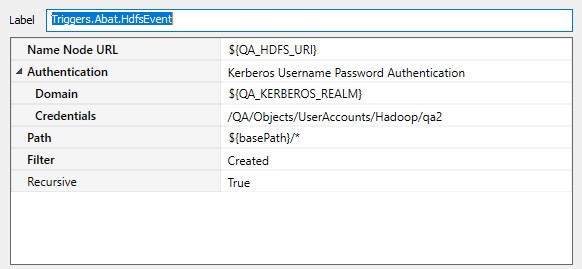
Name Node URL – The URL of the HDFS Name Node.
Authentication – This set of properties is used when executing on the HDFS Name Node. These credentials will be used to authenticate with Kerberos if necessary.
Path – Folder and file specification (including wildcards)
Filter – One or more operations concerning the file; Created, Appeared, Modified and Deleted.
Recursive – This Boolean property determines whether any sub-folders that are present in the path and examined in a recursive fashion.
This event trigger is only available via a separately purchased license. The Oracle DB Event Trigger allows you to obtain database events on a specified Oracle table. The events available are currently: Insert, Update and Delete modifications to a table.
This facility uses the Table’s transaction log file to seamlessly determine committed changes. While no changes are made to your database by ActiveBatch this facility (and the underlying LogMiner usage) does require that minimal supplemental logging be enabled. Please read the section on “Oracle DB Event Trigger” in the “ActiveBatch Installation and Administrator’s manual” for additional information.
Please note that as this facility exposes data within the specified table, ActiveBatch requires that the user requesting this event have a role of “DBA Access”.
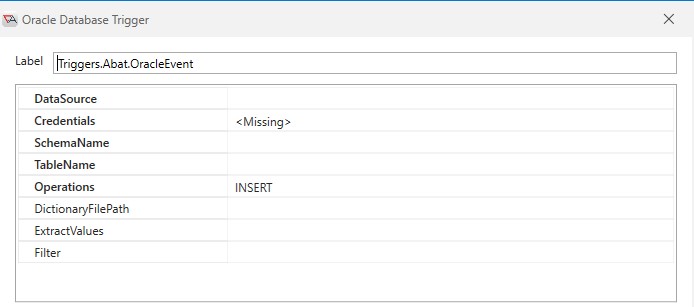
DataSource – This property references the target data source that the Schema and Table name are located on. This property also supports ActiveBatch variables.
Credentials – The object path of a User Account object. Clicking on the “Helper” will cause a tree display of all
ActiveBatch containers. You may then select a User Account object. The User Account credentials must have proper access to the target data source. Typically, the credentials will be a valid database username and password for this data source (unless Windows authentication is used in which the username/password will be a valid Windows account). This property also supports ActiveBatch variables.
SchemaName – The name of the schema which when used with the TableName identifies the desired table. This property also supports ActiveBatch variables.
TableName – The name of the desired table. This property also supports ActiveBatch variables.
Operations – This property indicates the operation(s) (and optionally “filter”) that you want ActiveBatch to declare an event. Valid operations are Insert, Update and Delete and may be specified by clicking on the property’s dropdown and checking those operations you are interested in.
DictionaryFilePath – This allows LogMiner to start in the context of a pluggable database (PDB) from the CDB level. To create the dictionary file (assuming UTL_FILE_DIR is set):
-
Login to the PDB where the trigger will be armed.
-
Create a new DIRECTORY or locate an existing one where the dictionary file will be stored on the file system (on the Oracle database server).
-
Generate the dictionary file via EXEC DBMS_LOGMNR_D.BUILD('<NAME>', '<DIRECTORY>', DBMS_LOGMNR_D.STORE_IN_FLAT_FILE)
This is the path that will be used in the Event Trigger.
LogMiner is used because this option prevents the system from modifying or locking your tables, and it reduces performance and file I/O impact. LogMiner is started from the CDB using the dictionary file. You will still need the appropriate privileges to arm the Event Trigger. In the event the trigger fails to arm, an access occur will occur.
These changes were specific to 12c+; however, because the DictionaryFilePath property is displayed for 11g as well, it is an optional field for Oracle 11g instances and CDB data sources. The field is required for any PDB data source.
ExtractValues – Depending on the operation you can extract field (columns) values from the change record and have them returned within the @Trigger.Values built-in ActiveBatch variable for later usage by the triggered object. For example, if the field ‘Value’ was specified the following variable specification could be used to access the data: @Trigger.Values.Value. The syntax for this property is to specify one or more separated fields.
Filter – The filter property allows you to refine your declaration of the event. With no filter specified, when the specified operation occurs an event is declared. When a filter expression is specified, the expression must evaluate to true for the operation to be declared an event. This allows very precise refinement of the database change that must take effect for the event to be declared. In the above example, VALUE=’${VALUE}’ this expression tests the table field VALUE against an ActiveBatch variable ${VALUE}. If the expression is true then an event would be declared. The expression syntax supported is the same as for constraints (meaning you can use Boolean operators, parenthesis, and arithmetic operations where applicable).
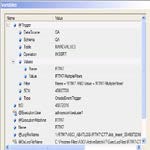
The above figure displays the @Trigger structure variables that are passed back from a successful Oracle Database event. Note the “Values” sub-structure. These variables are the column (field) and value that created the event. The “Operation” variable indicates that the event was caused by a table insert operation.
Note: On an Update operation the only variable values returned are those which have changed and also been specified in the “Extract” parameter. On a Delete operation, no variable values are returned for the fields within the deleted record/row.
This event trigger is only available with the SAP Netweaver license (which is separately licensed). The SAP Event Trigger allows you to trigger an ActiveBatch object (Job/Plan) based on any number of supported SAP events.

Login – This property is a User Account object that provides security credentialed access to an SAP system.
Event – This dropdown lists all the supported SAP events.
Select State – This dropdown lists the event state that is to be considered for the event trigger. Choices are: All – all events since the last time; New – new events since the last time and Confirmed – confirmed events since the last time.
Change NEW Event Status – A Boolean property that if true will change any event state to “Confirmed”.
Parameters – This optional property allows you to pass parameters to the triggered object (Job/Plan) when the event is triggered.
The ServiceNow Incident Trigger allows you to obtain events that occur on a specified ServiceNow instance. This event trigger is only available via a separately purchased license.
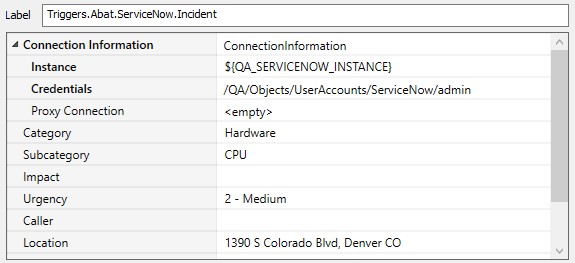
Connection Information: This set of properties describes the ServiceNow instance, security credentials and any proxy that must be used, to connect to the ServiceNow instance.
The properties list are those within the ServiceNow Incident. You may select specific values by using the helper dropdown. When an event matches those specified, a trigger is generated and executes the associated Plan or Job.
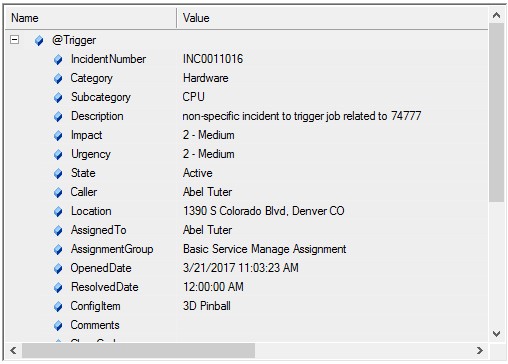
The above figure displays the @Trigger structure variables that are passed back from a successful ServiceNow trigger.
This event trigger is only available with the VMware license (which is separately licensed). The VMware Event Trigger allows you to obtain events that occur on a specified VMware Host system (and pertain to either the Host and/or Guest Operating System).
The initial portion of the event definition pertains to the selected VMware Host or vCenter system and security credentials for accessing that system. The optional portion consists of selecting the enumerated event and then selecting the event source. The event source can be either a: Virtual Machine, Host or Datacenter. In the example below, we’re interested in declaring an ActiveBatch event when a VmPoweredOffEvent occurs on the Virtual Machine QAVM. When the event occurs the associated Job or Plan will be instantiated and the details of the event are available through the standard @Trigger built-in variable.
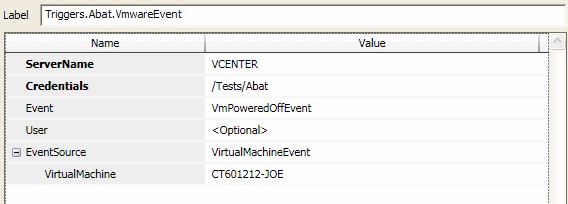
ServerName – Host Name or IP-address of the VMware Host or vCenter system. This property also supports ActiveBatch variables.
Credentials – The object path of a User Account object. Clicking on the “Helper” will cause a tree display of all ActiveBatch containers. You may then select a User Account object. The User Account credentials must have proper access to the VMware Host. Typically, the credentials will be a valid Windows username and password for this system. This property also supports ActiveBatch variables.
Event – This property, accessible through the dropdown, enumerates all the possible VMware events you might be interested in. If none is specified, then all possible events are eligible. The event list is dynamically accessed from the specified ServerName.
User – The object path of a User Account object. Clicking on the “Helper” will cause a tree display of all ActiveBatch containers. You may then select a User Account object. The User Account credentials must have proper access to the VMware Host. Typically, the credentials will be a valid Windows username and password for this system. This property also supports ActiveBatch variables. If omitted, the Credentials specified are used.
EventSource – This property allows you to select the source of the event. VMware currently supports three (3) types of events: VirtualMachineEvent, HostEvent and DatacenterEvent. Depending on your selection an additional property is displayed requesting the name of the underlying machine (either virtual machine, host or data center).
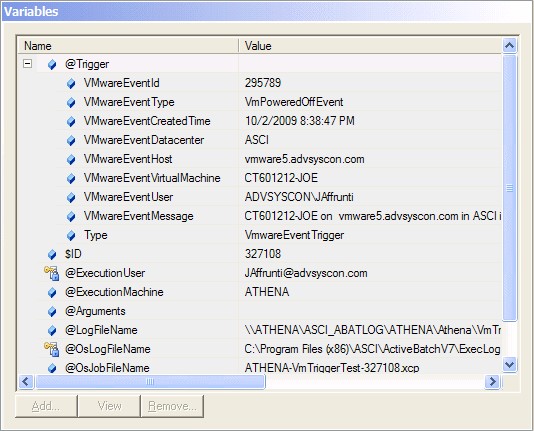
Depending on the event captured, ActiveBatch will pass information through the built-in @Trigger structure variable.
These values can be retrieved through ActiveBatch string substitution for use within the triggered ActiveBatch Job or Plan.